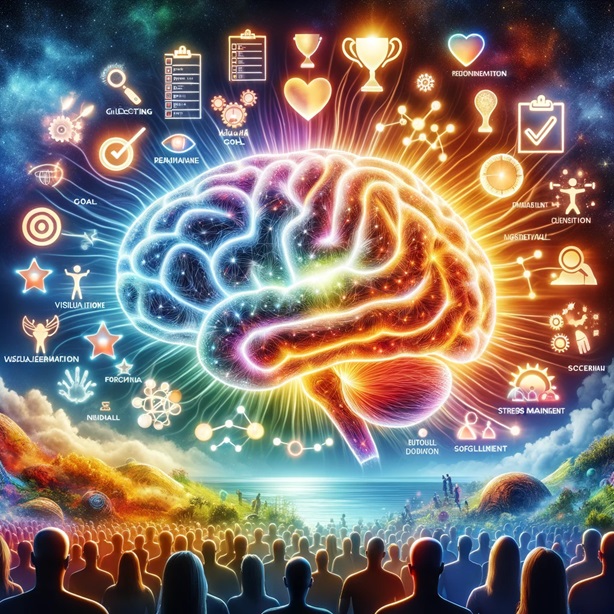The Science of Motivation
Motivation is a complex, multifaceted phenomenon that propels us to act towards goals. It's deeply rooted in the brain's reward system, particularly involving the neurotransmitter dopamine. This system influences the anticipatory desire that drives goal-oriented behavior and the reinforcement that comes from achieving those goals. Understanding how motivation works neurologically can unlock ways to enhance it, impacting productivity, learning, and overall quality of life.
Motivation is influenced by both intrinsic and extrinsic factors. Intrinsic motivation stems from internal desires, such as the pursuit of knowledge or personal satisfaction, while extrinsic motivation is driven by external rewards or pressures. Both types of motivation play crucial roles in shaping behavior and achieving goals.
Neural Pathways of Motivation
The neural circuitry of motivation primarily involves the mesolimbic pathway, originating in the ventral tegmental area and projecting to regions like the nucleus accumbens, known to mediate reward perception. Dysfunctions in this circuitry can lead to motivational deficits observed in various mental health conditions. Enhancing motivation involves both the activation of these pathways and the regulation of related neurotransmitter levels.
In addition to the mesolimbic pathway, the prefrontal cortex plays a key role in motivation. This brain region is involved in planning and decision-making, influencing how goals are set and pursued. The balance between these neural pathways determines how motivated an individual feels and how they act on their motivations.
Practical Techniques to Train Motivation
To train and enhance motivation, one can adopt several practical techniques:
- Goal Setting: Clear, achievable goals can boost motivation by providing direction and a sense of accomplishment. Goals should be specific, measurable, achievable, relevant, and time-bound (SMART) to maximize their effectiveness.
- Positive Reinforcement: Rewarding oneself for completing tasks can reinforce productive behavior. This can include tangible rewards or internal satisfaction, which engages the brain's reward system.
- Visualization: Visualizing successful outcomes can prime the brain's reward system, enhancing motivation. This technique involves imagining the process and outcome of achieving a goal, which increases motivation and focus.
- Managing Stress: Stress can hinder motivation; managing it through mindfulness or exercise can maintain motivational drive. Chronic stress can disrupt the balance of neurotransmitters involved in motivation, so stress reduction is crucial for maintaining motivation.
- Stimulating Environments: Engaging environments can stimulate the brain, fostering creativity and motivation. Changing the surroundings or incorporating elements like music can enhance motivation and productivity.
These techniques leverage the brain's neural pathways involved in motivation, enhancing the drive to pursue and achieve goals.
Overcoming Motivational Barriers
Procrastination and lack of motivation can be combated through:
- Structured Routines: Establishing routines can reduce the mental effort required to start tasks. Regular habits can create a framework for productive behavior, reducing the reliance on motivation alone.
- Breaking Down Tasks: Smaller tasks appear less daunting and can build momentum through quick wins. This approach makes larger goals feel more manageable and provides a sense of progress, boosting motivation.
- Social Support: Encouragement from peers or mentors can provide external motivation. Social support can also offer accountability, helping individuals stay on track with their goals.
- Self-Compassion: Being kind to oneself during setbacks can prevent demotivation. Practicing self-compassion fosters resilience and helps maintain motivation through challenges.
Overcoming motivational barriers involves both changing behavior and adjusting one's mindset to stay motivated and achieve goals.
Motivation Across the Lifespan
Motivation is not static; it changes throughout life. Recognizing and adapting to these changes can help maintain motivation. For example, older adults might find motivation in maintaining social connections and pursuing meaningful activities, whereas younger individuals may be driven by career aspirations or personal development.
Children and adolescents often exhibit intrinsic motivation towards play and learning, which can be nurtured to support development. In adulthood, motivation often shifts towards achieving long-term goals or fulfilling responsibilities. In later life, maintaining motivation can involve staying socially active and engaged in rewarding activities, which supports cognitive health and well-being.
Conclusion
While the neuroscience of motivation is complex, understanding it empowers us to harness this knowledge and apply practical strategies to enhance our motivational drive. By setting clear goals, managing stress, reinforcing productive behaviors, and creating stimulating environments, we can train our brains to remain motivated, achieving cognitive improvement and success in our personal and professional endeavors.
Motivation is a dynamic process influenced by both neural and psychological factors. By actively engaging in techniques that enhance motivation, individuals can improve their quality of life, achieve their goals, and maintain cognitive health across the lifespan.
